Organizational Change and Development Report: Air Asia Analysis
VerifiedAdded on 2022/11/17
|10
|2666
|455
Report
AI Summary
This report provides a comprehensive analysis of Air Asia's organizational changes, focusing on the airline's response to the dynamic business environment. It examines the nature of the changes implemented, including technological advancements, structural modifications, and new service offerings like the "Premium Flex" and "My Corporate" programs. The report identifies both internal and external forces driving these changes, such as lower profitability, competition, technological advancements, and evolving customer needs. It also explores the communication strategies employed during the change process, differentiating between monologic and dialogic communication styles, and offering a self-reflection on the effectiveness of these approaches. The report uses Lewin’s three-step model to understand the change management process and concludes by emphasizing the importance of continuous innovation and adaptation for maintaining a competitive advantage in the globalized aviation industry.
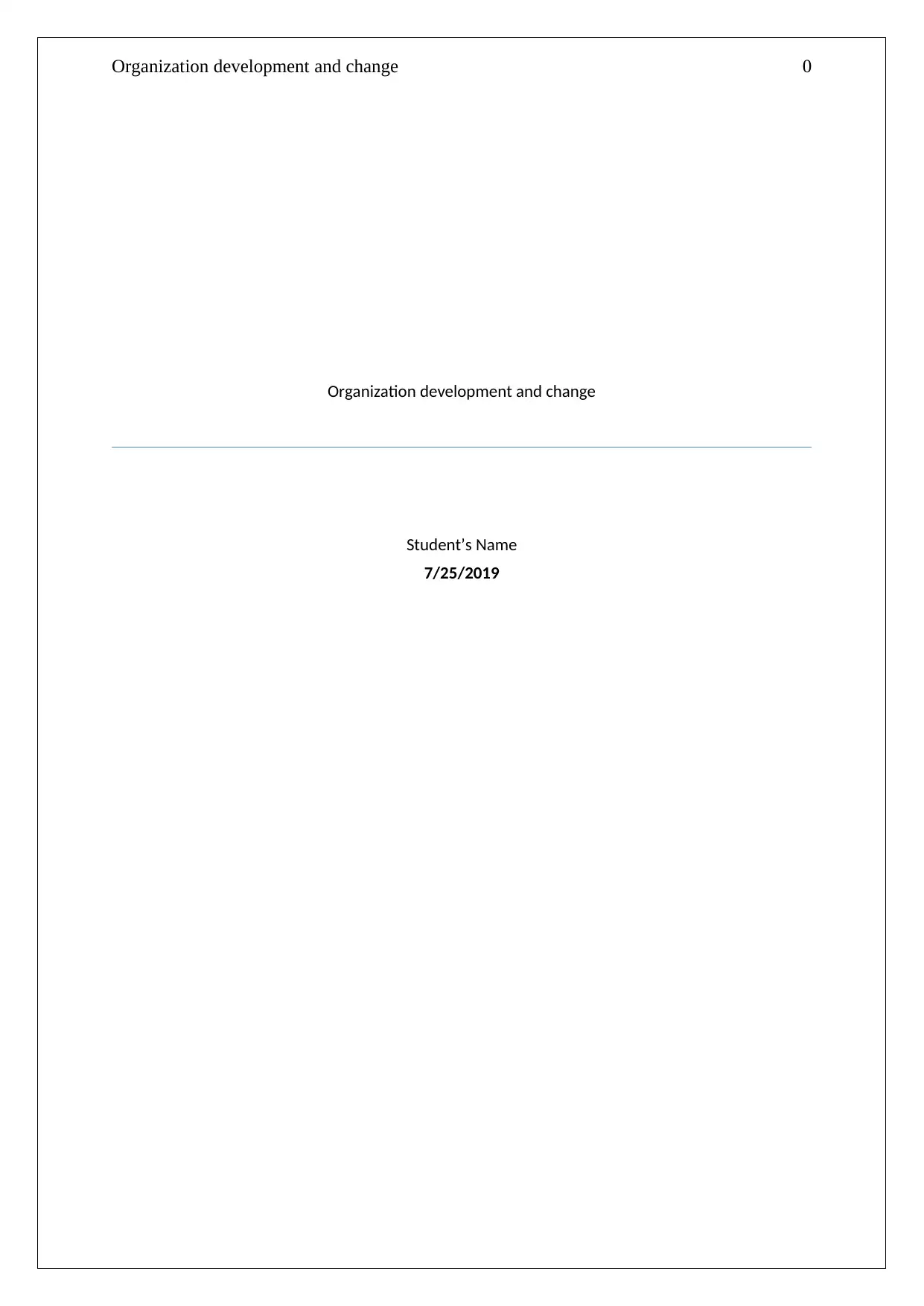
Organization development and change 0
Organization development and change
Student’s Name
7/25/2019
Organization development and change
Student’s Name
7/25/2019
Paraphrase This Document
Need a fresh take? Get an instant paraphrase of this document with our AI Paraphraser
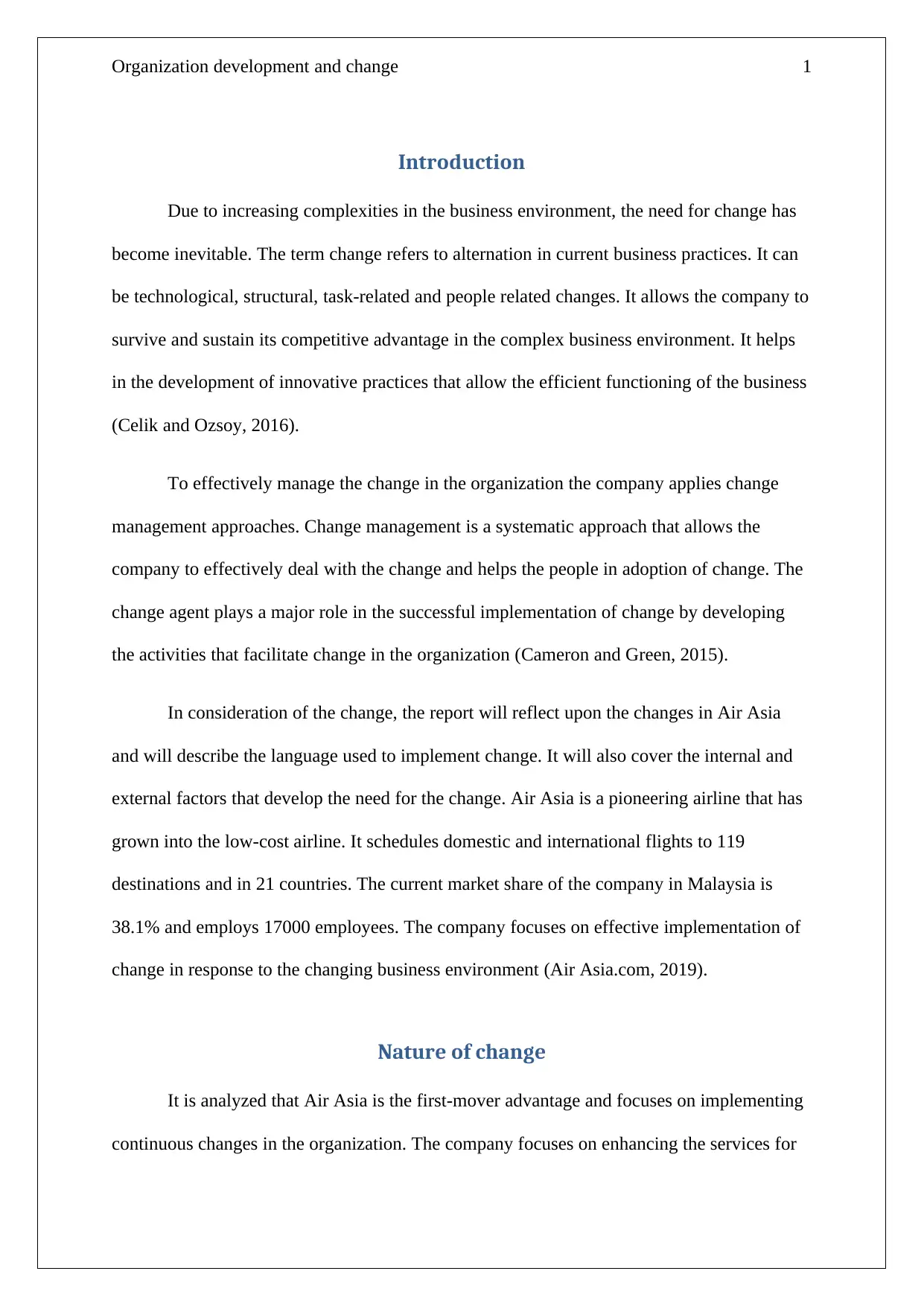
Organization development and change 1
Introduction
Due to increasing complexities in the business environment, the need for change has
become inevitable. The term change refers to alternation in current business practices. It can
be technological, structural, task-related and people related changes. It allows the company to
survive and sustain its competitive advantage in the complex business environment. It helps
in the development of innovative practices that allow the efficient functioning of the business
(Celik and Ozsoy, 2016).
To effectively manage the change in the organization the company applies change
management approaches. Change management is a systematic approach that allows the
company to effectively deal with the change and helps the people in adoption of change. The
change agent plays a major role in the successful implementation of change by developing
the activities that facilitate change in the organization (Cameron and Green, 2015).
In consideration of the change, the report will reflect upon the changes in Air Asia
and will describe the language used to implement change. It will also cover the internal and
external factors that develop the need for the change. Air Asia is a pioneering airline that has
grown into the low-cost airline. It schedules domestic and international flights to 119
destinations and in 21 countries. The current market share of the company in Malaysia is
38.1% and employs 17000 employees. The company focuses on effective implementation of
change in response to the changing business environment (Air Asia.com, 2019).
Nature of change
It is analyzed that Air Asia is the first-mover advantage and focuses on implementing
continuous changes in the organization. The company focuses on enhancing the services for
Introduction
Due to increasing complexities in the business environment, the need for change has
become inevitable. The term change refers to alternation in current business practices. It can
be technological, structural, task-related and people related changes. It allows the company to
survive and sustain its competitive advantage in the complex business environment. It helps
in the development of innovative practices that allow the efficient functioning of the business
(Celik and Ozsoy, 2016).
To effectively manage the change in the organization the company applies change
management approaches. Change management is a systematic approach that allows the
company to effectively deal with the change and helps the people in adoption of change. The
change agent plays a major role in the successful implementation of change by developing
the activities that facilitate change in the organization (Cameron and Green, 2015).
In consideration of the change, the report will reflect upon the changes in Air Asia
and will describe the language used to implement change. It will also cover the internal and
external factors that develop the need for the change. Air Asia is a pioneering airline that has
grown into the low-cost airline. It schedules domestic and international flights to 119
destinations and in 21 countries. The current market share of the company in Malaysia is
38.1% and employs 17000 employees. The company focuses on effective implementation of
change in response to the changing business environment (Air Asia.com, 2019).
Nature of change
It is analyzed that Air Asia is the first-mover advantage and focuses on implementing
continuous changes in the organization. The company focuses on enhancing the services for
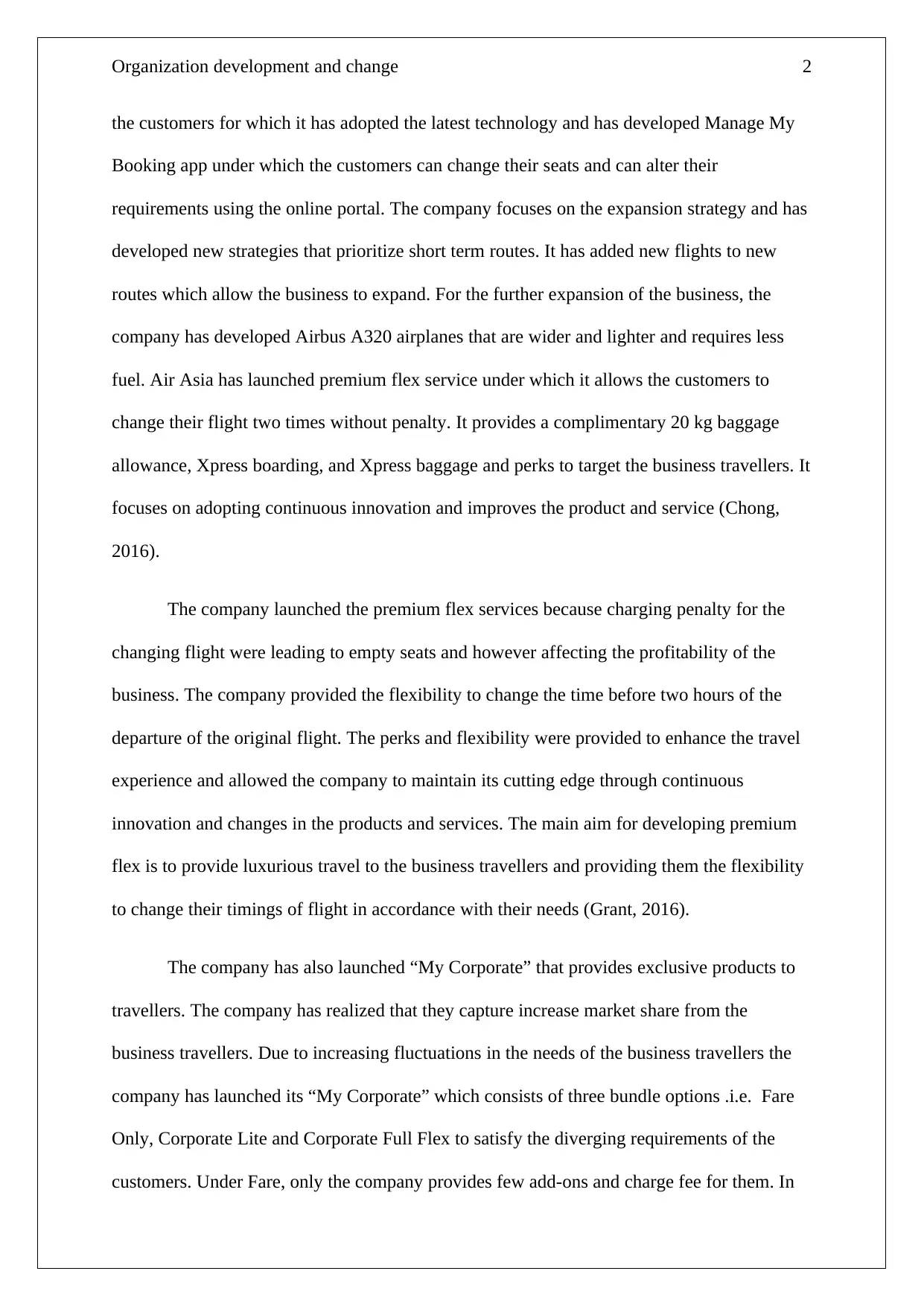
Organization development and change 2
the customers for which it has adopted the latest technology and has developed Manage My
Booking app under which the customers can change their seats and can alter their
requirements using the online portal. The company focuses on the expansion strategy and has
developed new strategies that prioritize short term routes. It has added new flights to new
routes which allow the business to expand. For the further expansion of the business, the
company has developed Airbus A320 airplanes that are wider and lighter and requires less
fuel. Air Asia has launched premium flex service under which it allows the customers to
change their flight two times without penalty. It provides a complimentary 20 kg baggage
allowance, Xpress boarding, and Xpress baggage and perks to target the business travellers. It
focuses on adopting continuous innovation and improves the product and service (Chong,
2016).
The company launched the premium flex services because charging penalty for the
changing flight were leading to empty seats and however affecting the profitability of the
business. The company provided the flexibility to change the time before two hours of the
departure of the original flight. The perks and flexibility were provided to enhance the travel
experience and allowed the company to maintain its cutting edge through continuous
innovation and changes in the products and services. The main aim for developing premium
flex is to provide luxurious travel to the business travellers and providing them the flexibility
to change their timings of flight in accordance with their needs (Grant, 2016).
The company has also launched “My Corporate” that provides exclusive products to
travellers. The company has realized that they capture increase market share from the
business travellers. Due to increasing fluctuations in the needs of the business travellers the
company has launched its “My Corporate” which consists of three bundle options .i.e. Fare
Only, Corporate Lite and Corporate Full Flex to satisfy the diverging requirements of the
customers. Under Fare, only the company provides few add-ons and charge fee for them. In
the customers for which it has adopted the latest technology and has developed Manage My
Booking app under which the customers can change their seats and can alter their
requirements using the online portal. The company focuses on the expansion strategy and has
developed new strategies that prioritize short term routes. It has added new flights to new
routes which allow the business to expand. For the further expansion of the business, the
company has developed Airbus A320 airplanes that are wider and lighter and requires less
fuel. Air Asia has launched premium flex service under which it allows the customers to
change their flight two times without penalty. It provides a complimentary 20 kg baggage
allowance, Xpress boarding, and Xpress baggage and perks to target the business travellers. It
focuses on adopting continuous innovation and improves the product and service (Chong,
2016).
The company launched the premium flex services because charging penalty for the
changing flight were leading to empty seats and however affecting the profitability of the
business. The company provided the flexibility to change the time before two hours of the
departure of the original flight. The perks and flexibility were provided to enhance the travel
experience and allowed the company to maintain its cutting edge through continuous
innovation and changes in the products and services. The main aim for developing premium
flex is to provide luxurious travel to the business travellers and providing them the flexibility
to change their timings of flight in accordance with their needs (Grant, 2016).
The company has also launched “My Corporate” that provides exclusive products to
travellers. The company has realized that they capture increase market share from the
business travellers. Due to increasing fluctuations in the needs of the business travellers the
company has launched its “My Corporate” which consists of three bundle options .i.e. Fare
Only, Corporate Lite and Corporate Full Flex to satisfy the diverging requirements of the
customers. Under Fare, only the company provides few add-ons and charge fee for them. In
⊘ This is a preview!⊘
Do you want full access?
Subscribe today to unlock all pages.

Trusted by 1+ million students worldwide
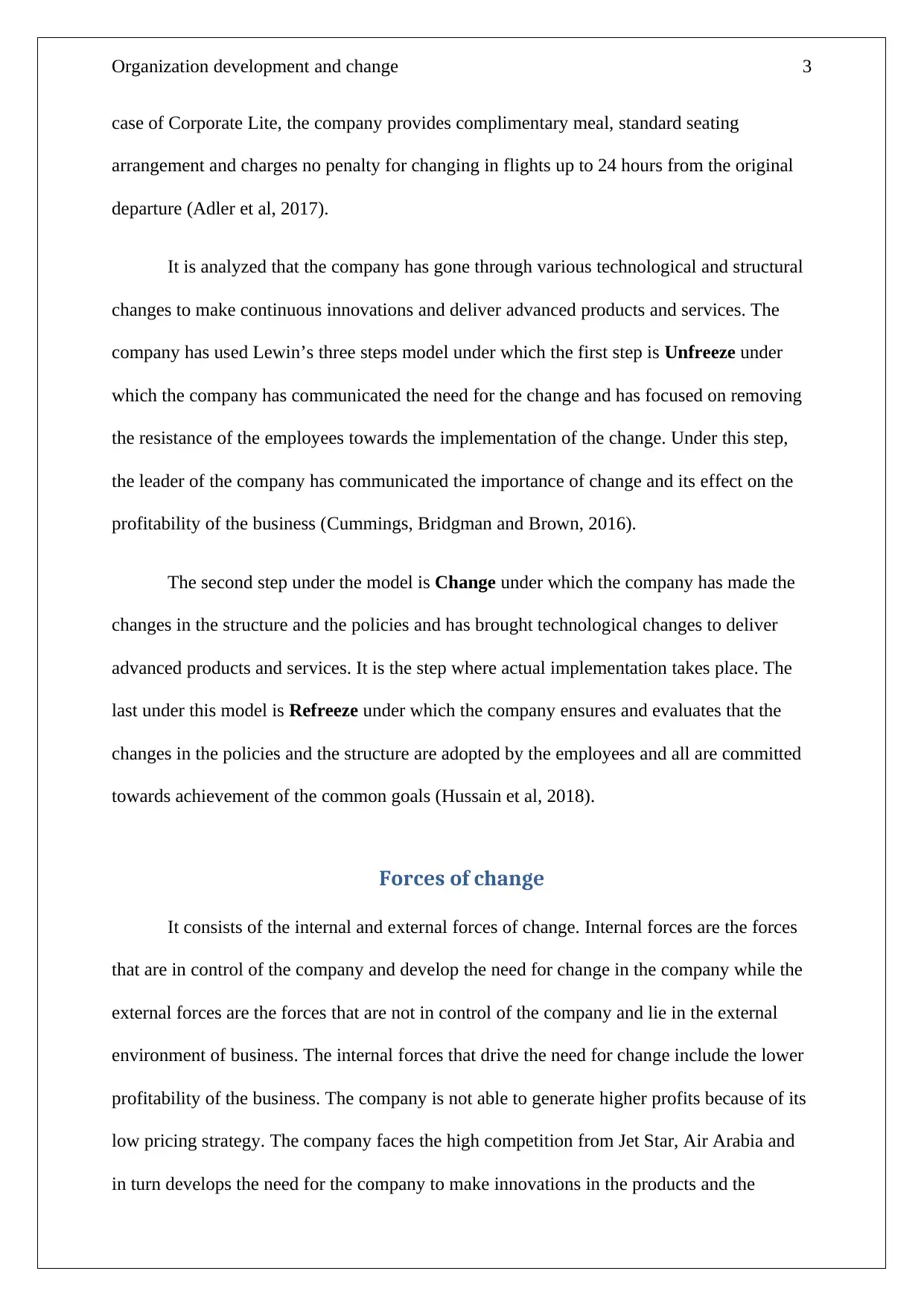
Organization development and change 3
case of Corporate Lite, the company provides complimentary meal, standard seating
arrangement and charges no penalty for changing in flights up to 24 hours from the original
departure (Adler et al, 2017).
It is analyzed that the company has gone through various technological and structural
changes to make continuous innovations and deliver advanced products and services. The
company has used Lewin’s three steps model under which the first step is Unfreeze under
which the company has communicated the need for the change and has focused on removing
the resistance of the employees towards the implementation of the change. Under this step,
the leader of the company has communicated the importance of change and its effect on the
profitability of the business (Cummings, Bridgman and Brown, 2016).
The second step under the model is Change under which the company has made the
changes in the structure and the policies and has brought technological changes to deliver
advanced products and services. It is the step where actual implementation takes place. The
last under this model is Refreeze under which the company ensures and evaluates that the
changes in the policies and the structure are adopted by the employees and all are committed
towards achievement of the common goals (Hussain et al, 2018).
Forces of change
It consists of the internal and external forces of change. Internal forces are the forces
that are in control of the company and develop the need for change in the company while the
external forces are the forces that are not in control of the company and lie in the external
environment of business. The internal forces that drive the need for change include the lower
profitability of the business. The company is not able to generate higher profits because of its
low pricing strategy. The company faces the high competition from Jet Star, Air Arabia and
in turn develops the need for the company to make innovations in the products and the
case of Corporate Lite, the company provides complimentary meal, standard seating
arrangement and charges no penalty for changing in flights up to 24 hours from the original
departure (Adler et al, 2017).
It is analyzed that the company has gone through various technological and structural
changes to make continuous innovations and deliver advanced products and services. The
company has used Lewin’s three steps model under which the first step is Unfreeze under
which the company has communicated the need for the change and has focused on removing
the resistance of the employees towards the implementation of the change. Under this step,
the leader of the company has communicated the importance of change and its effect on the
profitability of the business (Cummings, Bridgman and Brown, 2016).
The second step under the model is Change under which the company has made the
changes in the structure and the policies and has brought technological changes to deliver
advanced products and services. It is the step where actual implementation takes place. The
last under this model is Refreeze under which the company ensures and evaluates that the
changes in the policies and the structure are adopted by the employees and all are committed
towards achievement of the common goals (Hussain et al, 2018).
Forces of change
It consists of the internal and external forces of change. Internal forces are the forces
that are in control of the company and develop the need for change in the company while the
external forces are the forces that are not in control of the company and lie in the external
environment of business. The internal forces that drive the need for change include the lower
profitability of the business. The company is not able to generate higher profits because of its
low pricing strategy. The company faces the high competition from Jet Star, Air Arabia and
in turn develops the need for the company to make innovations in the products and the
Paraphrase This Document
Need a fresh take? Get an instant paraphrase of this document with our AI Paraphraser
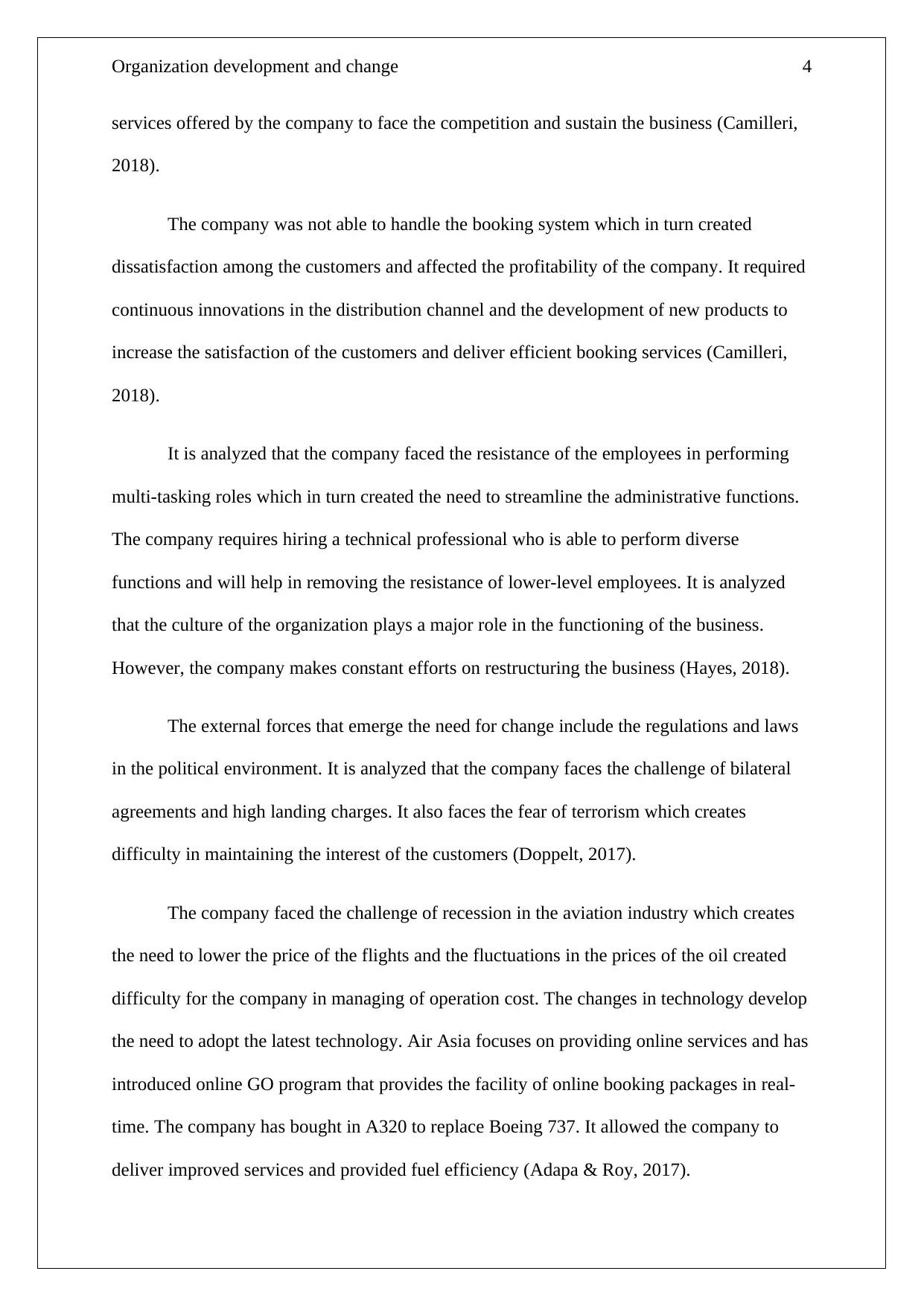
Organization development and change 4
services offered by the company to face the competition and sustain the business (Camilleri,
2018).
The company was not able to handle the booking system which in turn created
dissatisfaction among the customers and affected the profitability of the company. It required
continuous innovations in the distribution channel and the development of new products to
increase the satisfaction of the customers and deliver efficient booking services (Camilleri,
2018).
It is analyzed that the company faced the resistance of the employees in performing
multi-tasking roles which in turn created the need to streamline the administrative functions.
The company requires hiring a technical professional who is able to perform diverse
functions and will help in removing the resistance of lower-level employees. It is analyzed
that the culture of the organization plays a major role in the functioning of the business.
However, the company makes constant efforts on restructuring the business (Hayes, 2018).
The external forces that emerge the need for change include the regulations and laws
in the political environment. It is analyzed that the company faces the challenge of bilateral
agreements and high landing charges. It also faces the fear of terrorism which creates
difficulty in maintaining the interest of the customers (Doppelt, 2017).
The company faced the challenge of recession in the aviation industry which creates
the need to lower the price of the flights and the fluctuations in the prices of the oil created
difficulty for the company in managing of operation cost. The changes in technology develop
the need to adopt the latest technology. Air Asia focuses on providing online services and has
introduced online GO program that provides the facility of online booking packages in real-
time. The company has bought in A320 to replace Boeing 737. It allowed the company to
deliver improved services and provided fuel efficiency (Adapa & Roy, 2017).
services offered by the company to face the competition and sustain the business (Camilleri,
2018).
The company was not able to handle the booking system which in turn created
dissatisfaction among the customers and affected the profitability of the company. It required
continuous innovations in the distribution channel and the development of new products to
increase the satisfaction of the customers and deliver efficient booking services (Camilleri,
2018).
It is analyzed that the company faced the resistance of the employees in performing
multi-tasking roles which in turn created the need to streamline the administrative functions.
The company requires hiring a technical professional who is able to perform diverse
functions and will help in removing the resistance of lower-level employees. It is analyzed
that the culture of the organization plays a major role in the functioning of the business.
However, the company makes constant efforts on restructuring the business (Hayes, 2018).
The external forces that emerge the need for change include the regulations and laws
in the political environment. It is analyzed that the company faces the challenge of bilateral
agreements and high landing charges. It also faces the fear of terrorism which creates
difficulty in maintaining the interest of the customers (Doppelt, 2017).
The company faced the challenge of recession in the aviation industry which creates
the need to lower the price of the flights and the fluctuations in the prices of the oil created
difficulty for the company in managing of operation cost. The changes in technology develop
the need to adopt the latest technology. Air Asia focuses on providing online services and has
introduced online GO program that provides the facility of online booking packages in real-
time. The company has bought in A320 to replace Boeing 737. It allowed the company to
deliver improved services and provided fuel efficiency (Adapa & Roy, 2017).
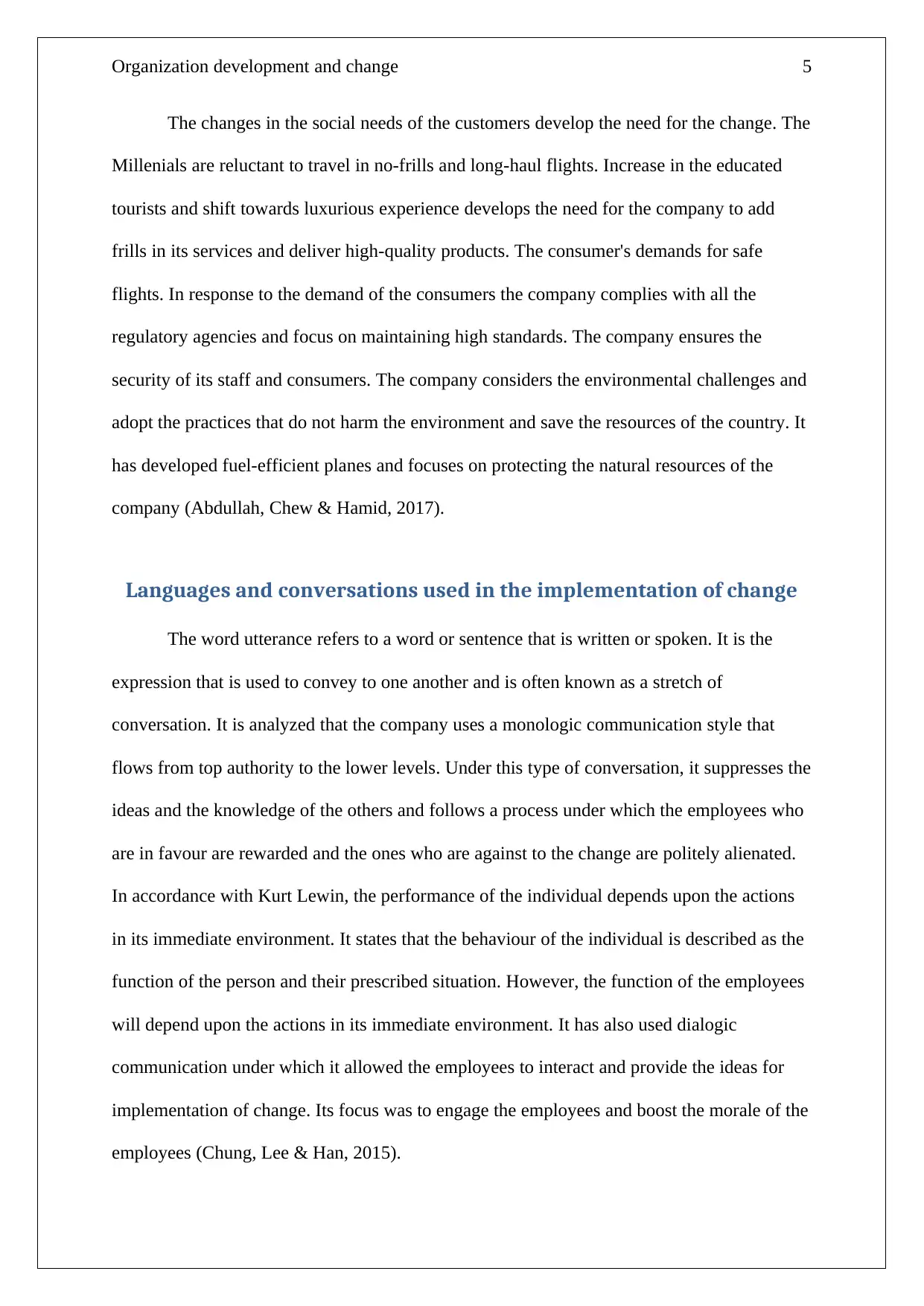
Organization development and change 5
The changes in the social needs of the customers develop the need for the change. The
Millenials are reluctant to travel in no-frills and long-haul flights. Increase in the educated
tourists and shift towards luxurious experience develops the need for the company to add
frills in its services and deliver high-quality products. The consumer's demands for safe
flights. In response to the demand of the consumers the company complies with all the
regulatory agencies and focus on maintaining high standards. The company ensures the
security of its staff and consumers. The company considers the environmental challenges and
adopt the practices that do not harm the environment and save the resources of the country. It
has developed fuel-efficient planes and focuses on protecting the natural resources of the
company (Abdullah, Chew & Hamid, 2017).
Languages and conversations used in the implementation of change
The word utterance refers to a word or sentence that is written or spoken. It is the
expression that is used to convey to one another and is often known as a stretch of
conversation. It is analyzed that the company uses a monologic communication style that
flows from top authority to the lower levels. Under this type of conversation, it suppresses the
ideas and the knowledge of the others and follows a process under which the employees who
are in favour are rewarded and the ones who are against to the change are politely alienated.
In accordance with Kurt Lewin, the performance of the individual depends upon the actions
in its immediate environment. It states that the behaviour of the individual is described as the
function of the person and their prescribed situation. However, the function of the employees
will depend upon the actions in its immediate environment. It has also used dialogic
communication under which it allowed the employees to interact and provide the ideas for
implementation of change. Its focus was to engage the employees and boost the morale of the
employees (Chung, Lee & Han, 2015).
The changes in the social needs of the customers develop the need for the change. The
Millenials are reluctant to travel in no-frills and long-haul flights. Increase in the educated
tourists and shift towards luxurious experience develops the need for the company to add
frills in its services and deliver high-quality products. The consumer's demands for safe
flights. In response to the demand of the consumers the company complies with all the
regulatory agencies and focus on maintaining high standards. The company ensures the
security of its staff and consumers. The company considers the environmental challenges and
adopt the practices that do not harm the environment and save the resources of the country. It
has developed fuel-efficient planes and focuses on protecting the natural resources of the
company (Abdullah, Chew & Hamid, 2017).
Languages and conversations used in the implementation of change
The word utterance refers to a word or sentence that is written or spoken. It is the
expression that is used to convey to one another and is often known as a stretch of
conversation. It is analyzed that the company uses a monologic communication style that
flows from top authority to the lower levels. Under this type of conversation, it suppresses the
ideas and the knowledge of the others and follows a process under which the employees who
are in favour are rewarded and the ones who are against to the change are politely alienated.
In accordance with Kurt Lewin, the performance of the individual depends upon the actions
in its immediate environment. It states that the behaviour of the individual is described as the
function of the person and their prescribed situation. However, the function of the employees
will depend upon the actions in its immediate environment. It has also used dialogic
communication under which it allowed the employees to interact and provide the ideas for
implementation of change. Its focus was to engage the employees and boost the morale of the
employees (Chung, Lee & Han, 2015).
⊘ This is a preview!⊘
Do you want full access?
Subscribe today to unlock all pages.

Trusted by 1+ million students worldwide
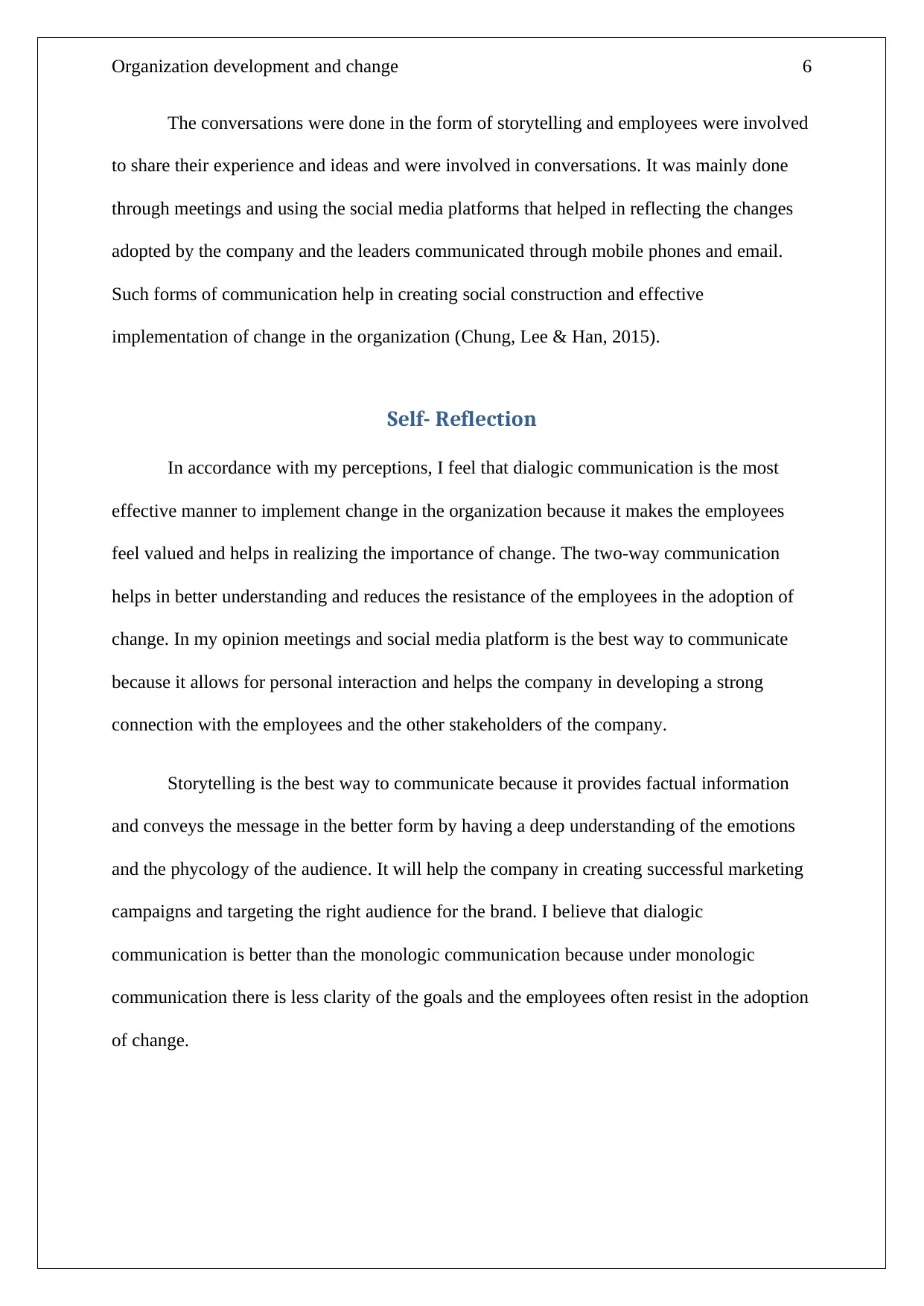
Organization development and change 6
The conversations were done in the form of storytelling and employees were involved
to share their experience and ideas and were involved in conversations. It was mainly done
through meetings and using the social media platforms that helped in reflecting the changes
adopted by the company and the leaders communicated through mobile phones and email.
Such forms of communication help in creating social construction and effective
implementation of change in the organization (Chung, Lee & Han, 2015).
Self- Reflection
In accordance with my perceptions, I feel that dialogic communication is the most
effective manner to implement change in the organization because it makes the employees
feel valued and helps in realizing the importance of change. The two-way communication
helps in better understanding and reduces the resistance of the employees in the adoption of
change. In my opinion meetings and social media platform is the best way to communicate
because it allows for personal interaction and helps the company in developing a strong
connection with the employees and the other stakeholders of the company.
Storytelling is the best way to communicate because it provides factual information
and conveys the message in the better form by having a deep understanding of the emotions
and the phycology of the audience. It will help the company in creating successful marketing
campaigns and targeting the right audience for the brand. I believe that dialogic
communication is better than the monologic communication because under monologic
communication there is less clarity of the goals and the employees often resist in the adoption
of change.
The conversations were done in the form of storytelling and employees were involved
to share their experience and ideas and were involved in conversations. It was mainly done
through meetings and using the social media platforms that helped in reflecting the changes
adopted by the company and the leaders communicated through mobile phones and email.
Such forms of communication help in creating social construction and effective
implementation of change in the organization (Chung, Lee & Han, 2015).
Self- Reflection
In accordance with my perceptions, I feel that dialogic communication is the most
effective manner to implement change in the organization because it makes the employees
feel valued and helps in realizing the importance of change. The two-way communication
helps in better understanding and reduces the resistance of the employees in the adoption of
change. In my opinion meetings and social media platform is the best way to communicate
because it allows for personal interaction and helps the company in developing a strong
connection with the employees and the other stakeholders of the company.
Storytelling is the best way to communicate because it provides factual information
and conveys the message in the better form by having a deep understanding of the emotions
and the phycology of the audience. It will help the company in creating successful marketing
campaigns and targeting the right audience for the brand. I believe that dialogic
communication is better than the monologic communication because under monologic
communication there is less clarity of the goals and the employees often resist in the adoption
of change.
Paraphrase This Document
Need a fresh take? Get an instant paraphrase of this document with our AI Paraphraser
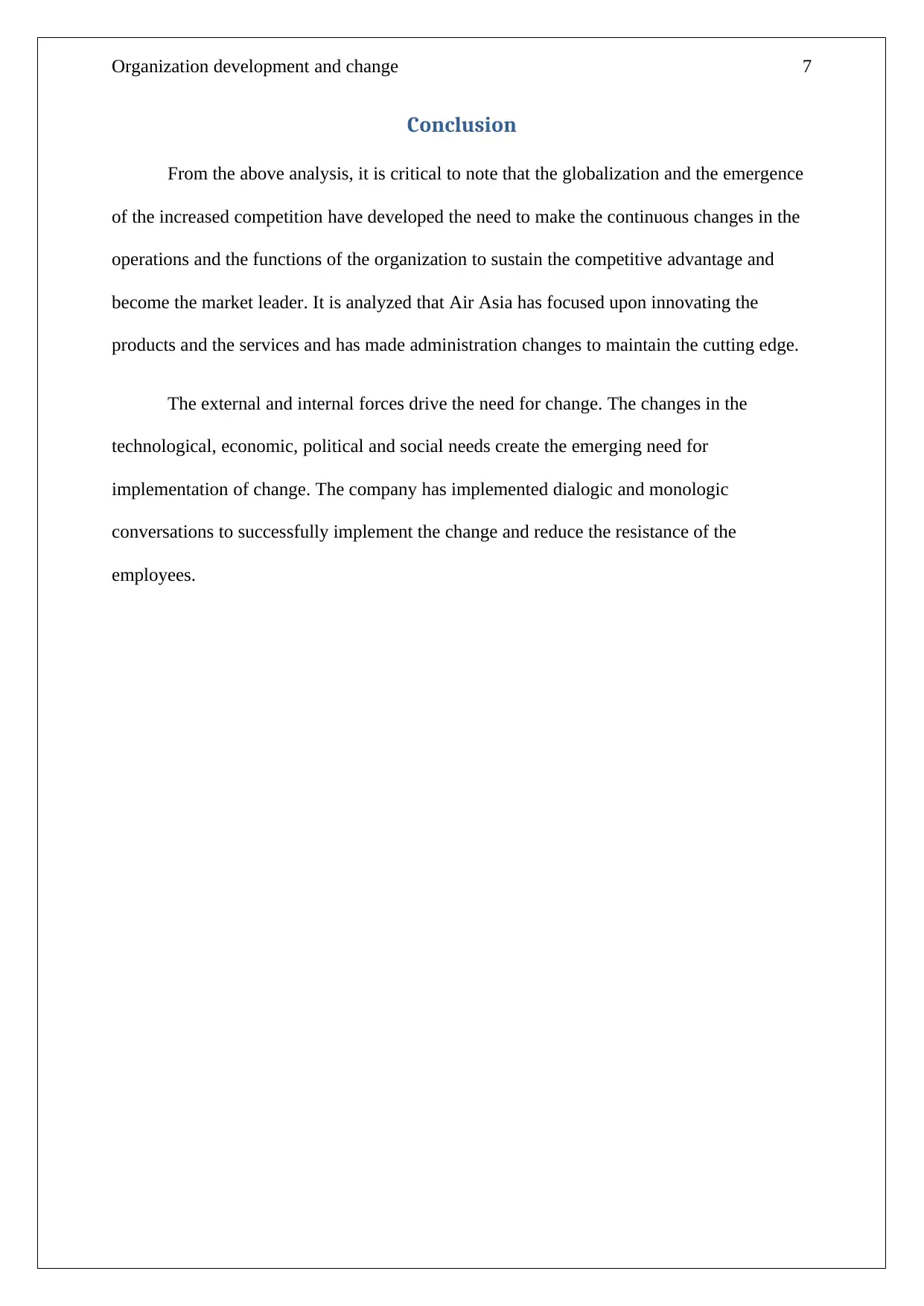
Organization development and change 7
Conclusion
From the above analysis, it is critical to note that the globalization and the emergence
of the increased competition have developed the need to make the continuous changes in the
operations and the functions of the organization to sustain the competitive advantage and
become the market leader. It is analyzed that Air Asia has focused upon innovating the
products and the services and has made administration changes to maintain the cutting edge.
The external and internal forces drive the need for change. The changes in the
technological, economic, political and social needs create the emerging need for
implementation of change. The company has implemented dialogic and monologic
conversations to successfully implement the change and reduce the resistance of the
employees.
Conclusion
From the above analysis, it is critical to note that the globalization and the emergence
of the increased competition have developed the need to make the continuous changes in the
operations and the functions of the organization to sustain the competitive advantage and
become the market leader. It is analyzed that Air Asia has focused upon innovating the
products and the services and has made administration changes to maintain the cutting edge.
The external and internal forces drive the need for change. The changes in the
technological, economic, political and social needs create the emerging need for
implementation of change. The company has implemented dialogic and monologic
conversations to successfully implement the change and reduce the resistance of the
employees.
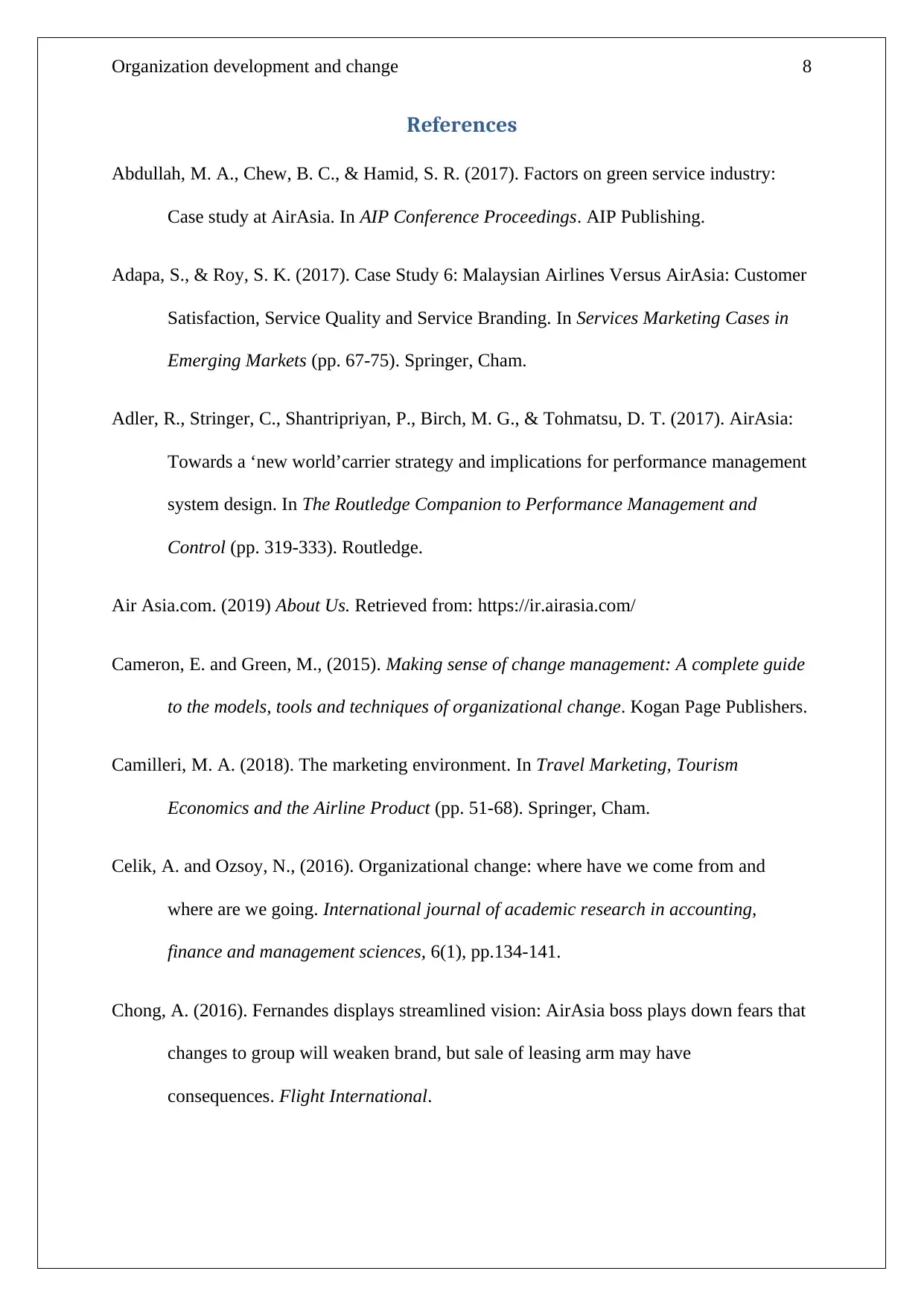
Organization development and change 8
References
Abdullah, M. A., Chew, B. C., & Hamid, S. R. (2017). Factors on green service industry:
Case study at AirAsia. In AIP Conference Proceedings. AIP Publishing.
Adapa, S., & Roy, S. K. (2017). Case Study 6: Malaysian Airlines Versus AirAsia: Customer
Satisfaction, Service Quality and Service Branding. In Services Marketing Cases in
Emerging Markets (pp. 67-75). Springer, Cham.
Adler, R., Stringer, C., Shantripriyan, P., Birch, M. G., & Tohmatsu, D. T. (2017). AirAsia:
Towards a ‘new world’carrier strategy and implications for performance management
system design. In The Routledge Companion to Performance Management and
Control (pp. 319-333). Routledge.
Air Asia.com. (2019) About Us. Retrieved from: https://ir.airasia.com/
Cameron, E. and Green, M., (2015). Making sense of change management: A complete guide
to the models, tools and techniques of organizational change. Kogan Page Publishers.
Camilleri, M. A. (2018). The marketing environment. In Travel Marketing, Tourism
Economics and the Airline Product (pp. 51-68). Springer, Cham.
Celik, A. and Ozsoy, N., (2016). Organizational change: where have we come from and
where are we going. International journal of academic research in accounting,
finance and management sciences, 6(1), pp.134-141.
Chong, A. (2016). Fernandes displays streamlined vision: AirAsia boss plays down fears that
changes to group will weaken brand, but sale of leasing arm may have
consequences. Flight International.
References
Abdullah, M. A., Chew, B. C., & Hamid, S. R. (2017). Factors on green service industry:
Case study at AirAsia. In AIP Conference Proceedings. AIP Publishing.
Adapa, S., & Roy, S. K. (2017). Case Study 6: Malaysian Airlines Versus AirAsia: Customer
Satisfaction, Service Quality and Service Branding. In Services Marketing Cases in
Emerging Markets (pp. 67-75). Springer, Cham.
Adler, R., Stringer, C., Shantripriyan, P., Birch, M. G., & Tohmatsu, D. T. (2017). AirAsia:
Towards a ‘new world’carrier strategy and implications for performance management
system design. In The Routledge Companion to Performance Management and
Control (pp. 319-333). Routledge.
Air Asia.com. (2019) About Us. Retrieved from: https://ir.airasia.com/
Cameron, E. and Green, M., (2015). Making sense of change management: A complete guide
to the models, tools and techniques of organizational change. Kogan Page Publishers.
Camilleri, M. A. (2018). The marketing environment. In Travel Marketing, Tourism
Economics and the Airline Product (pp. 51-68). Springer, Cham.
Celik, A. and Ozsoy, N., (2016). Organizational change: where have we come from and
where are we going. International journal of academic research in accounting,
finance and management sciences, 6(1), pp.134-141.
Chong, A. (2016). Fernandes displays streamlined vision: AirAsia boss plays down fears that
changes to group will weaken brand, but sale of leasing arm may have
consequences. Flight International.
⊘ This is a preview!⊘
Do you want full access?
Subscribe today to unlock all pages.

Trusted by 1+ million students worldwide
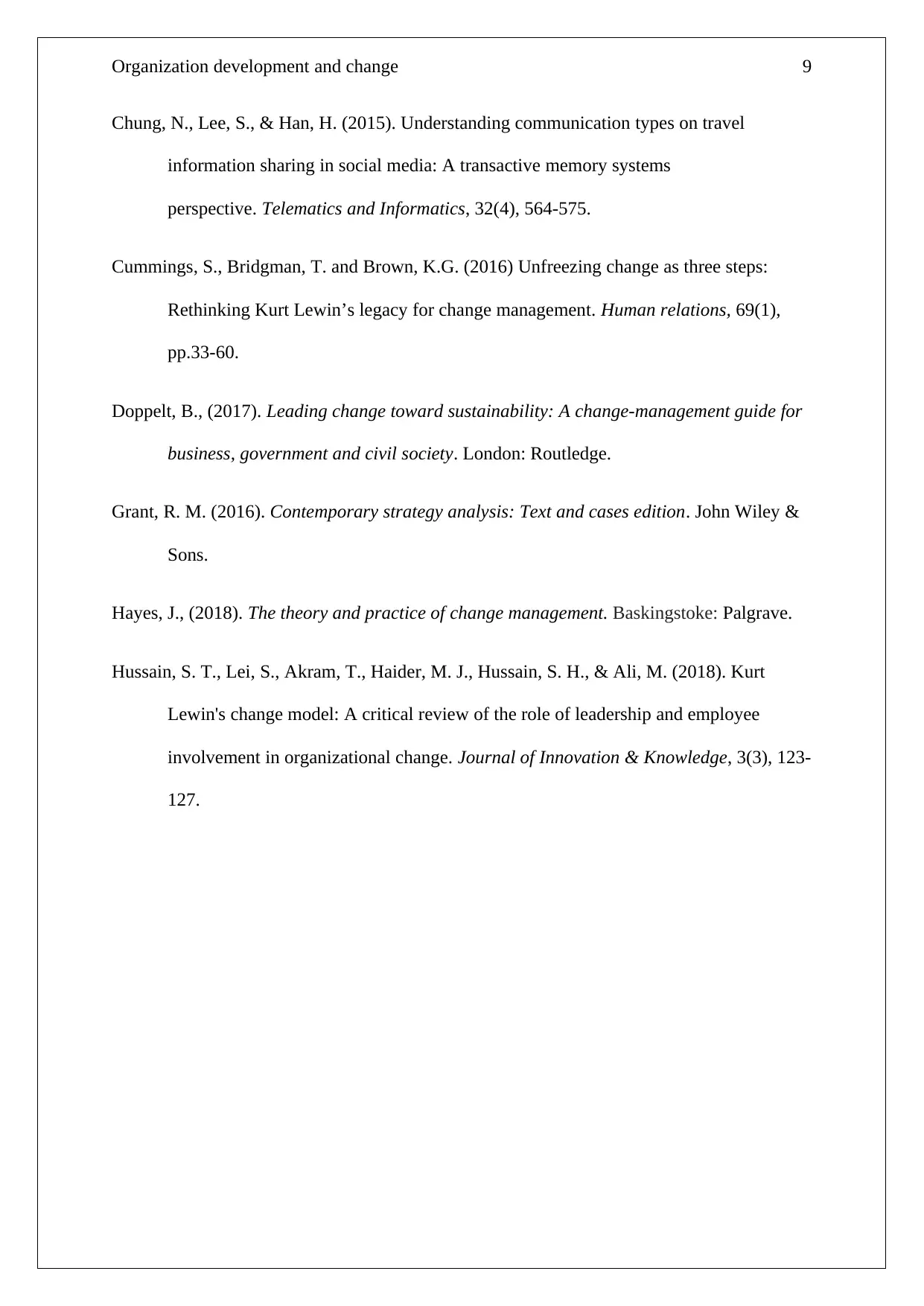
Organization development and change 9
Chung, N., Lee, S., & Han, H. (2015). Understanding communication types on travel
information sharing in social media: A transactive memory systems
perspective. Telematics and Informatics, 32(4), 564-575.
Cummings, S., Bridgman, T. and Brown, K.G. (2016) Unfreezing change as three steps:
Rethinking Kurt Lewin’s legacy for change management. Human relations, 69(1),
pp.33-60.
Doppelt, B., (2017). Leading change toward sustainability: A change-management guide for
business, government and civil society. London: Routledge.
Grant, R. M. (2016). Contemporary strategy analysis: Text and cases edition. John Wiley &
Sons.
Hayes, J., (2018). The theory and practice of change management. Baskingstoke: Palgrave.
Hussain, S. T., Lei, S., Akram, T., Haider, M. J., Hussain, S. H., & Ali, M. (2018). Kurt
Lewin's change model: A critical review of the role of leadership and employee
involvement in organizational change. Journal of Innovation & Knowledge, 3(3), 123-
127.
Chung, N., Lee, S., & Han, H. (2015). Understanding communication types on travel
information sharing in social media: A transactive memory systems
perspective. Telematics and Informatics, 32(4), 564-575.
Cummings, S., Bridgman, T. and Brown, K.G. (2016) Unfreezing change as three steps:
Rethinking Kurt Lewin’s legacy for change management. Human relations, 69(1),
pp.33-60.
Doppelt, B., (2017). Leading change toward sustainability: A change-management guide for
business, government and civil society. London: Routledge.
Grant, R. M. (2016). Contemporary strategy analysis: Text and cases edition. John Wiley &
Sons.
Hayes, J., (2018). The theory and practice of change management. Baskingstoke: Palgrave.
Hussain, S. T., Lei, S., Akram, T., Haider, M. J., Hussain, S. H., & Ali, M. (2018). Kurt
Lewin's change model: A critical review of the role of leadership and employee
involvement in organizational change. Journal of Innovation & Knowledge, 3(3), 123-
127.
1 out of 10
Related Documents
Your All-in-One AI-Powered Toolkit for Academic Success.
+13062052269
info@desklib.com
Available 24*7 on WhatsApp / Email
![[object Object]](/_next/static/media/star-bottom.7253800d.svg)
Unlock your academic potential
Copyright © 2020–2025 A2Z Services. All Rights Reserved. Developed and managed by ZUCOL.





